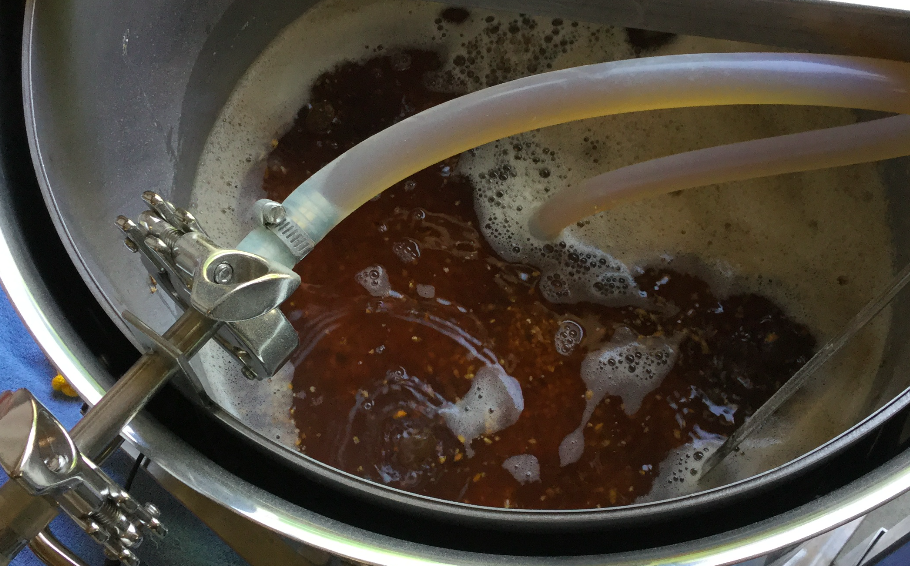Brewed again today and things went very smoothly. I think I am zeroing in on what works for me. Mash efficiency was 78.6% and I did not have to babysit the mash and poke at it. While it is possible to get better efficiency, I'm happy with anything in the 70s as long as it is consistent and easy!
This batch used 11.3 lbs of grain, double-milled on my shop's mill which they say is gapped to .045". I added 1/2 lb of rice hulls to the mash. I did not enter the rice hulls into BeerSmith, so it did not calculate any water absorption for them. I did this because I'd rather come up a bit short on the post-mash volume and do a mini-sparge than end up with more volume than I wanted.
I used the Ss manifold, and placed it on top of the grain. I had to start the pump slow, but after 15-20 minutes the grain bed had settled more and I was able to turn it up to about 2/3 speed. I only stirred the grain bed once, at about the 5 minute mark--otherwise, it was hands off other than fiddling with the pump speed. You really have to be patient... You can't just max out the pump from the beginning, at least with my grain:water ratio.
I have no way of knowing for sure if there was any channeling going on, but the wort became very clear, which made me think there was good flow and self-filtering going on. It almost looked like a couple inches of tea with the grain bed underneath it. This isn't a great picture but you get the idea.
I came up about .3 gallons short after the mash, and poured that amount through the grain bed after lifting the basket. (I mash the grain with a pot lid to help squeeze out the wort.)
I hit my desired volume into the fermenter of 5.75 gallons. Mash efficiency was 78.6%, brewhouse efficiency 77%. This was my easiest brew so far, too, because I committed to letting the manifold and pump do all the work.
Takeaways:
- Double-mill or crush fine--double-milling @ .045" made big difference for me.
- Put the manifold on top of the grain and run the pump as fast as you can without overdoing it.
- Rice hulls? I say yes. I'm going to standardize on 8 oz for a typical batch.
- Don't stir the grain, trust the pump and manifold.
These are my BeerSmith settings for the 20 gallon system with the solid-sided basket.
Brewhouse Efficiency: 75%
BIAB Grain Absorb: 0.4960 fl oz/oz (default is .586, find this in Preferences/Advanced)
Equipment profile:
Batch Size: 5.75 gal
Mash Volume: 15.00 gal
Boil Volume: 7.74 gal
Mash Tun Weight: 25 lbs
Evaporation Rate: 17.2 % (1.33 gal/hr when boiling ~7 gallons at 55% power)
Mash Tun Specific Heat: 0.12 cal/g-deg C (doesn't really matter as I dough-in under PID manual control)
Boil Time: 60
Mash Tun Deadspace: 0.01 gal (may as well be zero I guess!)
Top-up for Boiler: 0.00 gal
Equip Hop Utilization: 100.00 %
Losses to Trub/Chiller: 0.40 gal (increase this if you want more leftover wort safety margin)
Cooling Loss (%): 4.00
Top up water for Fermenter: 0.00 gal
Hope this helps someone!












![Craft A Brew - Safale S-04 Dry Yeast - Fermentis - English Ale Dry Yeast - For English and American Ales and Hard Apple Ciders - Ingredients for Home Brewing - Beer Making Supplies - [1 Pack]](https://m.media-amazon.com/images/I/41fVGNh6JfL._SL500_.jpg)















































